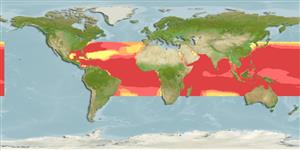Common names from other countries
Environment: milieu / climate zone / depth range / distribution range
Ökologie
seewasser; ozeanodrom (Ref. 51243); tiefenbereich 0 - 20 m. Subtropical; 40°N - 25°S
Indo-West Pacific: Red Sea and South Africa (including the Mascarenes, Ref. 33390) to southern Japan, Taiwan, Mariana, Caroline and Solomon islands, Queensland and the Arafura Sea (Ref. 9819). Western Atlantic: New Jersey, USA and northern Gulf of Mexico (Ref. 7251) to Rio de Janeiro, Brazil. Eastern Atlantic: Guinea to Gabon.
Size / Gewicht / Alter
Maturity: Lm ? range ? - ? cm
Max length : 40.0 cm TL Männchen/unbestimmt; (Ref. 5217); common length : 25.0 cm TL Männchen/unbestimmt; (Ref. 5217)
Rückenflossenstacheln (insgesamt) : 0; Rückenflossenweichstrahlen (insgesamt) : 12 - 14; Afterflossenstacheln: 0; Afterflossenweichstrahlen: 9 - 11. Body dark, iridescent blue dorsally, silvery white below; pectorals bluish black; dorsal fin with prominent black spot (Ref. 2797).
Inhabits both neritic and oceanic surface waters (Ref. 30573). Capable of leaping out of the water and gliding for long distances above the surface (Ref. 30573). Feeds mostly on crustaceans and other planktonic organisms; often attracted to lights at night (Ref. 2797).
Life cycle and mating behavior
Maturities | Fortpflanzung | Spawnings | Egg(s) | Fecundities | Larven
Parin, N.V., 1996. On the species composition of flying fishes (Exocoetidae) in the West-Central part of tropical Pacific. J. Ichthyol. 36(5):357-364. (Ref. 27313)
IUCN Rote Liste Status (Ref. 130435)
CITES (Ref. 128078)
Not Evaluated
Bedrohung für Menschen
Harmless
Nutzung durch Menschen
Fischereien: weniger kommerziell
Tools
Zusatzinformationen
Download XML
Internet Quellen
Estimates based on models
Preferred temperature (Ref.
115969): 21.7 - 29.1, mean 27.5 (based on 25528 cells).
Phylogenetic diversity index (Ref.
82804): PD
50 = 0.5000 [Uniqueness, from 0.5 = low to 2.0 = high].
Bayesian length-weight: a=0.00646 (0.00292 - 0.01429), b=3.04 (2.84 - 3.24), in cm Total Length, based on LWR estimates for this (Sub)family-body shape (Ref.
93245).
Trophic level (Ref.
69278): 3.3 ±0.38 se; based on food items.
Widerstandsfähigkeit (Ref.
120179): hoch, Verdopplung der Population dauert weniger als 15 Monate. (K=0.8).
Fishing Vulnerability (Ref.
59153): Low vulnerability (21 of 100).
